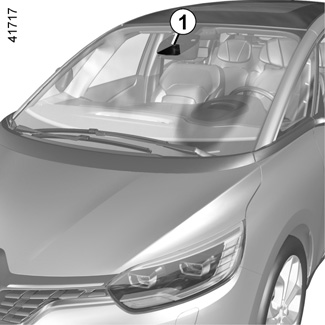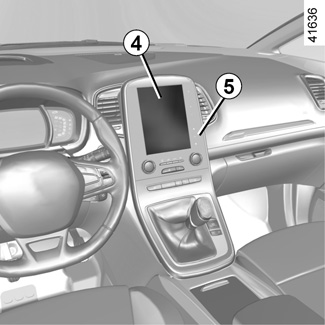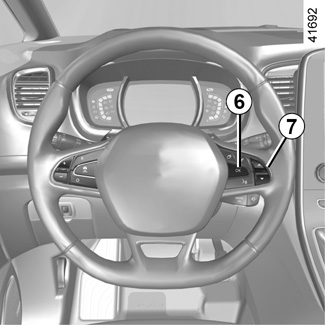ACTIVE EMERGENCY BRAKING

Using information from the radar-camera 1, the system calculates the distance which separates it from the vehicle in front and the surrounding pedestrians.
It notifies the driver if there is a risk of head-on collision. The driver can then brake the vehicle to limit the damage arising from a collision.
Note: make sure the windscreen is not obscured (dirt, mud, snow, condensation etc.).
This system can apply maximum braking to the vehicle until it is completely stationary if necessary.
For safety reasons, always wear your seat belt when travelling in your vehicle and make sure that it is loaded so that no items can be thrown forward and hit the occupants.
This function is an additional driving aid. This function is not under any circumstances intended to replace the due care and attention of the driver, who should at all times be in control of the vehicle.

Detection of vehicles
Operation
When driving (speed between about 4.34 and 99.2 mph (7 and 160 km/h)), if there is a risk of collision with the vehicle in front, the system:
- warns you of a collision risk:
- the warning light is displayed in red on the instrument panel, accompanied by a beep;
or
- the indicator 2 is displayed in red on the instrument panel and, depending on the vehicle, on the head up display, accompanied by a beep.
If the driver depresses the brake pedal and the system still detects a risk of collision, the brake force is increased.
- braking may be triggered: when the vehicle is moving slower than approximately 75 mph (120 km/h), if the driver does not respond to the warning and a collision becomes imminent.
Special features
When the vehicle speed:
- is less than 27.9 mph (45 km/h) approximately, the warning and braking are activated at the same time;
- is between about 27.9 mph (45 km/h) and 48 mph (80 km/h) approximately, the warning is activated. Braking will only be triggered if the vehicle preceding you is moving. Braking is not activated for stationary vehicles;
- is between about 48 mph (80 km/h) and 99.2 mph (160 km/h), the warning and braking are only triggered if the vehicle preceding you is moving. The warning and braking are not activated for stationary vehicles;
- is above 99.2 mph (160 km/h), the system is not active.
In the event of an emergency manoeuvre, you can stop braking at any moment by:
- tapping the accelerator pedal;
or
- turning the steering wheel as a collision avoidance manoeuvre.

Detection of pedestrians
Operation
When driving (speed between about 4.2 mph (7 km/h) and 36 mph (60 km/h), when there is a risk of impact with a pedestrian:
- the warning light is displayed in red on the instrument panel, accompanied by a beep;
or
- the indicator 3 is displayed in red on the instrument panel and, depending on the vehicle, on the head up display, accompanied by a beep.
When the impact is imminent, the system activates the braking.
The system can apply maximum braking to the vehicle until it is completely stationary if necessary.

Activating or deactivating the system
For vehicles fitted with a navigation system
From the multifunction screen 4, select menu “Vehicle”, “Driving assistance”, “Active braking” then choose “ON” or “OFF”.
You can access menu “Driving assistance” directly from button 5 .

For vehicle not fitted with a navigation system
- With the vehicle at a standstill, press and hold the switch 6 OK to access the settings menu;
- repeatedly press the control 7 up or down until you reach the “Driving assistance” menu. Press the switch 6 OK;
- repeatedly press control 7 up or down until you reach the “Active braking” menu, then press the switch 6 OK.
Press the switch 6 OK again to activate or deactivate the function:
= function activated
< function deactivated
The warning light is displayed on the instrument panel when the system is deactivated.
This system is reactivated each time the ignition is switched on.
Conditions for non-activation of the system
The system cannot be activated:
- when the gear lever is in neutral;
- when the parking brake is activated;
- while cornering.
As a general rule, if the driver shows signs of attention (action on the steering wheel, pedals etc.), the system delays its operation or does not activate.
Temporarily not available
When the system detects a temporary unavailability, the warning light lights up on the instrument panel accompanied by the message “Active braking: sensor blind” or, depending on the vehicle, “Radar-camera: no visibility”.
The possible causes are:
- the system is temporarily blinded (glare from the sun, dipped beam headlights, bad weather conditions etc.). The system will be operational again when visibility conditions are better;
- the system is temporarily disrupted (for example: windscreen obscured by dirt, ice, snow etc.). In this case, park the vehicle and switch off the engine. Clean the windscreen. When you next start the engine, the warning light and the message go out;
- if this is not the case, this may arise from another cause; contact an Approved Dealer.
Operating faults
When the system detects an operating fault, the warning light lights up on the instrument panel, with the message “Active braking disconnected”. Consult an approved dealer
Active emergency braking
This function is an additional driving aid. This function is not under any circumstances intended to replace the due care and attention of the driver, who should at all times be in control of the vehicle. The triggering of this function may be delayed or prevented when the system detects clear signs of control of the vehicle by the driver (action on the steering wheel, pedals etc.).
System servicing/repairs
- In the event of an impact, the radar-camera alignment may be changed, and its operation may consequently be affected. Deactivate the function, then consult an authorised dealer.
- Any work in the area where the radar-camera is located (repairs, replacements, windscreen modifications etc.) must be carried out by a qualified professional.
Only an authorised dealer is qualified to service the system.
In the event of system disturbance
Some conditions can disturb or damage the operation of the system, such as:
- a complex environment (metal bridge, tunnel etc.);
- poor weather conditions (snow, hail, black ice etc.);
- poor visibility (night, fog etc.);
- poor contrast between the object (vehicle, pedestrian etc.) and the surrounding area (e.g. pedestrian dressed in white located in a snowy area etc.);
- being dazzled (glaring sun, lights of vehicles travelling in the opposite direction etc.);
- windscreen obscured (by dirt, ice, snow, condensation etc.).
- ...
In these conditions, the system may not react, may warn the driver or may brake inadvertently.
Limitation of the system operation
- A vehicle travelling in the opposite direction will not trigger any alert or any action on the system operation.
- The radar-camera area on the windscreen should be kept clean and free of any modifications in order to ensure the proper operation of the system.
- The system cannot respond to small vehicles such as motorbikes or bicycles as effectively as to other vehicles.
- The system may not operate properly when the road surface is slippery (rain, snow, black ice etc.).
- To ensure correct operation, the system needs to distinguish the complete outline of the pedestrian. So the system cannot detect:
- pedestrians in the darkness or in poor lighting conditions;
- partially visible pedestrians:
- pedestrians less than approximately 80 cm tall;
- pedestrians carrying large objects;
- ...
In these conditions, the system may not react, may warn the driver or may brake inadvertently.
Deactivating the function
You must disable the function if:
- the brake lights are not functioning;
- the area of the radar-camera has been damaged (on the windscreen side or the interior rear-view mirror side);
- the vehicle is being towed (breakdowns);
- the windscreen is cracked or distorted (do not carry out repairs on this area of the windscreen; have it changed by an Authorised Dealer).
In the event of the system behaving abnormally, deactivate it and consult an authorised dealer.
Halting the function
You can halt the active braking function at any time by tapping the accelerator pedal or by turning the steering wheel in an avoidance manoeuvre.
